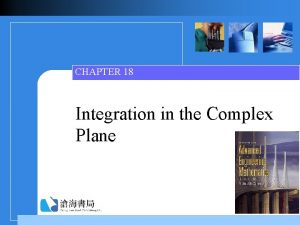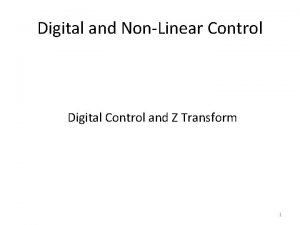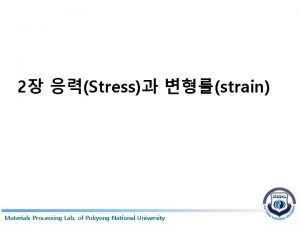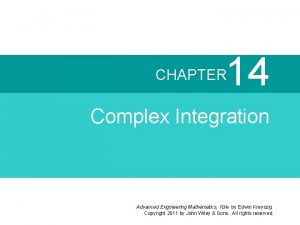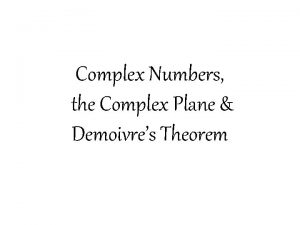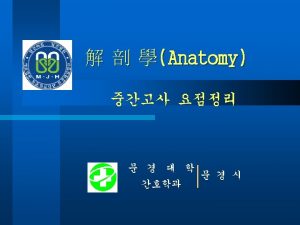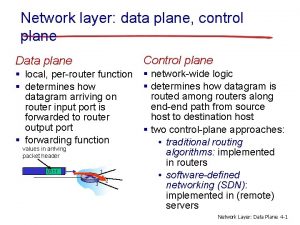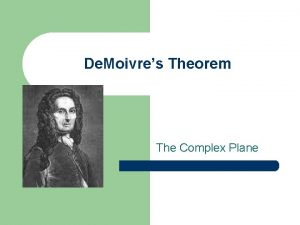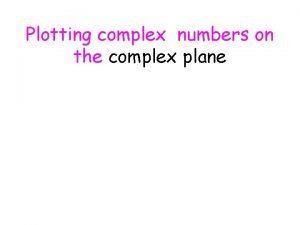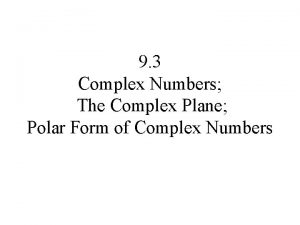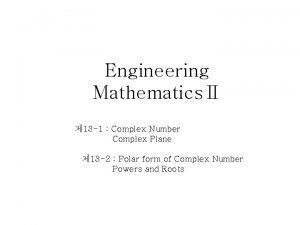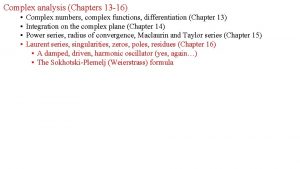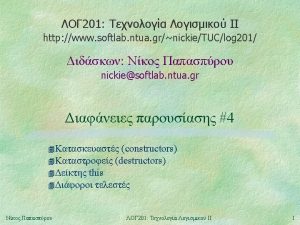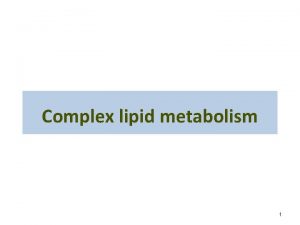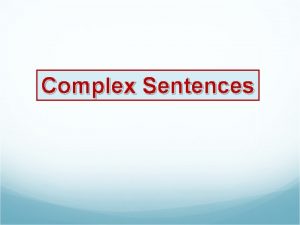CHAPTER 18 Integration in the Complex Plane Contents



































































- Slides: 67

CHAPTER 18 Integration in the Complex Plane

Contents v 18. 1 Contour Integrals v 18. 2 Cauchy-Goursat Theorem v 18. 3 Independence of Path v 18. 4 Cauchy’s Integral Formulas 2

18. 1 Contour Integrals DEFINITION 18. 1 Contour Integral Let f be defined at points of a smooth curve C given by The contour integral of f along C is (1) 3

THEOREM 18. 1 Evaluation of a Contour Integral If f is continuous on a smooth curve C given by , then (3) 4

Example 1 Solution 5

Example 2 Evaluate where C is the circle x = cos t, y = sin t, 0 t 2. Solution 6

THEOREM 18. 2 Properties of Contour Integrals Suppose f and g are continuous in a domain D and C is a smooth curve lying entirely in D. Then: (i) (iii) where C is the union of the smooth curve C 1 and C 2. (iv) where –C denotes the curve having the opposite orientation of C. 7

Example 3 Evaluate where C is the contour in Fig 18. 1. Solution Fig 18. 1 8

Example 3 (2) We have Since C 1 is defined by y = x, then z(x) = x + ix, z’(x) = 1 + i, f(z(x)) = x 2 + ix 2 , and 9

Example 3 (3) The curve C 2 is defined by x = 1, 1 y 2. Then z(y) = 1 + iy, z’(y) = i, f(z(y)) = 1 + iy 2. Thus 10

THEOREM 18. 3 A Bounding Theorem If f is continuous on a smooth curve C and if for all z on C, then where L is the length of C. v This theorem is sometimes called the ML-inequality 11

Example 4 Find an upper bound for the absolute value of where C is the circle |z| = 4. Solution Since |z +1| |z| − 1 = 3, then (5) 12

Example 4 (2) In addition, |ez| = ex, with |z| = 4, we have the maximum value of x is 4. Thus (5) becomes Hence from Theorem 18. 3, 13

18. 2 Cauchy-Goursat Theorem v Cauchy’s Theorem Suppose that a function f is analytic in a simply connected domain D and that f is continuous in D. Then for every simple closed contour C in D, This proof is based on the result of Green’s Theorem. (1) 14

v Now since f is analytic, the Cauchy-Riemann equations imply the integral in (1) is identical zero. THEOREM 18. 4 Cauchy-Goursat Theorem Suppose a function f is a analytic in a simply connected domain D. Then for every simple closed C in D, 15

v Since the interior of a simple closed contour is a simply connected domain, the Cauchy-Goursat Theorem can be stated as If f is analytic at all points within and on a simple closed contour C, (2) 16

Example 1 Evaluate where C is shown in Fig 18. 9. Solution The function ez is entire and C is a simple closed contour. Thus the integral is zero. 17

Fig 18. 9 18

Example 2 Evaluate where C is the ellipse (x – 2)2 + (y – 5)2/4 = 1. Solution We find that 1/z 2 is analytic except at z = 0 and z = 0 is not a point interior to or on C. Thus the integral is zero. 19

Cauchy-Goursat Theorem for Multiply Connected Domains v Fig 18. 11(a) shows that C 1 surrounds the “hole” in the domain and is interior to C. 20

v Suppose also that f is analytic on each contour and at each point interior to C but exterior to C 1. When we introduce the cut AB shown in Fig 18. 11(b), the region bounded by the curves is simply connected. Thus from (2) and (3) 21

Fig 18. 11 (b) 22

Example 4 Evaluate where C is the outer contour in Fig 18. 12. Solution From (3), we choose the simpler circular contour C 1: |z – i| = 1 in the figure. Thus x = cos t, y = 1 + sin t, 0 t 2 , or z = i + eit, 0 t 2. Then 23

Fig 18. 12 24

v The result in Example 4 can be generalized. We can show that if z 0 is any constant complex number interior to any simple closed contour C, then (4) 25

Example 5 Evaluate where C is the circle |z – 2| = 2. Solution and so (5) 26

Example 5 (2) Since z = 1 is interior to C and z = − 3 is exterior to C, we have 27

Fig 18. 13 v See Fig 18. 13. We can show that 28

THEOREM 18. 5 Cauchy-Goursat Theorem for Multiply Connected Domain Suppose C, C 1, …, Cn are simple closed curves with a positive orientation such that C 1, C 2, …, Cn are interior to C but the regions interior to each Ck, k = 1, 2, …, n, have no points in common. If f is analytic on each contour and at each point interior to C but exterior to all the Ck, k = 1, 2, …, n, then (6) 29

Example 6 Evaluate where C is the circle |z| = 3. Solution 30

Example 6 (2) We now surround the points z = i and z = −i by circular contours C 1 and C 2. See Fig 18. 14, we have (7) 31

18. 3 Independence of Path DEFINITION 18. 2 Independence of the Path Let z 0 and z 1 be points in a domain D. A contour integral is said to be independent of the path if its value is the same for all contours C in D with an initial point z 0 and a terminal point z 1. v See Fig 18. 19. 32

Fig 18. 19 33

v Note that C and C 1 form a closed contour. If f is analytic in D then (2) Thus (3) 34

THEOREM 18. 6 Analyticity Implies Path Independence If f is an analytic function in a simply connected domain D, then is independent of the path C. 35

Example 1 Evaluate where C is shown in Fig 18. 20. 36

Example 1 (2) Solution Since f(z) = 2 z is entire, we choose the path C 1 to replace C (see Fig 18. 20). C 1 is a straight line segment x = − 1, 0 y 1. Thus z = − 1 + iy, dz = idy. 37

DEFINITION 18. 3 Antiderivative Suppose f is continuous in a domain D. If there exists a function F such that F’(z) = f(z) for each z in D, then F is called an antiderivative of f. 38

THEOREM 18. 7 Fundamentals Theorem for Contour Integrals Suppose f is continuous in a domain D and F is an antiderivative of f in D. Then for any contour C in D with initial point z 0 and terminal point z 1, (4) 39

THEOREM 18. 7 Proof With F (z) = f(z) for each z in D, we have ← Chain Rule 40

Example 2 In Example 1, the contour is from − 1 to − 1 + i. The function f(z) = 2 z is entire and F(z) = z 2 such that F’(z) = 2 z = f(z). Thus 41

Example 3 Evaluate where C is any contour fro z = 0 to z = 2 + i. Solution 42

Some Conclusions from Theorem 18. 7 v If C is closed then z 0 = z 2, then (5) v In other words: If a continuous function f has an antiderivative F in D, then is independent of the path. (6) v Sufficient condition for the existence of an antiderivative: If f is continuous and is independent of the path in a domain D, then f has an antiderivative everywhere in D. (7) 43

THEOREM 18. 8 Existence of a Antiderivative If f is analytic in a simply connected domain D, then f has an antiderivative in D; that is, there existence a function F such that F’(z) = f(z) for all z in D. 44

Example 4 Evaluate where C is shown in Fig 18. 22. 45

Example 4 (2) Solution Suppose that D is the simply connected domain defined by x > 0, y > 0. In this case Ln z is an antiderivative of 1/z. Hence 46

18. 4 Cauchy Integral Formulas THEOREM 18. 9 Cauchy’s Integral Formula Let f be analytic in a simply connected domain D, and let C be a simple closed contour lying entirely within D. If z 0 is any point within C, then (1) 47

THEOREM 18. 9 Proof Let C 1 be a circle centered at z 0 with radius small enough that it is interior to C. Then we have (2) For the right side of (2) (3) 48

THEOREM 18. 9 proof From (4) of Sec. 18. 2, we know Thus (3) becomes (4) However from the ML-inequality and the fact that the length of C 1 is small enough, the second term of the right side in (4) is zero. We complete the proof. 49

v A more practical restatement of Theorem 18. 9 is : If f is analytic at all points within and on a simple closed contour C, and z 0 is any point interior to C, then (5) 50

Example 1 Evaluate where C is the circle |z| = 2. Solution First f = z 2 – 4 z + 4 is analytic and z 0 = −i is within C. Thus 51

Example 2 Evaluate where C is the circle |z – 2 i | = 4. Solution See Fig 18. 25. Only z = 3 i is within C, and 52

Fig 18. 25 53

Example 2 (2) 54

Example 3 The complex function where k = a + ib and z 1 are complex numbers, gives rise to a flow in the domain z z 1. If C is a simple closed contour containing z = z 1 in its interior, then we have 55

Example 3 (2) The circulation around C is 2 b and the net flux across C is 2 a. If z 1 were in the exterior of C both of them would be zero. Note that when k is real, the circulation around C is zero but the net flux across C is 2 k. The complex number z 1 is called a source when k > 0 and is a sink when k < 0. See Fig 18. 26. 56

Fig 18. 26 57

THEOREM 18. 10 Cauchy’s Integral Formula For Derivative Let f be analytic in a simply connected domain D, and let C be a simple closed contour lying entirely within D. If z 0 is any point within C, then (6) 58

THEOREM 18. 10 Partial Proof Prove only for n = 1. From the definition of the derivative and (1): 59

THEOREM 18. 10 Partial Proof From the ML-inequality and Thus 60

Example 4 Evaluate where C is the circle |z| = 1. Solution This integrand is not analytic at z = 0, − 4 but only z = 0 lies within C. Since We get z 0 = 0, n = 2, f(z) = (z + 1)/(z + 4), f (z) = − 6/(z + 4)3. By (6): 61

Example 5 Evaluate where C is shown in Fig 18. 27. 62

Example 5 (2) Solution Though C is not simple, we can think of it is as the union of two simple closed contours C 1 and C 2 in Fig 18. 27. 63

Example 5 (3) For I 1 : z 0 = 0 , f(z) = (z 3 + 3)/(z – i)2 : For I 2 : z 0 = i, n = 1, f(z) = (z 3 + 3)/z, f ’(z) = (2 z 3 – 3 )/z 2: We get 64

Liouville’s Theorem v If we take the contour C to be the circle |z – z 0| = r, from (6) and ML-inequality that (7) where |f(z)| M for all points on C. The result in (7) is called Cauchy’s inequality. 65

THEOREM 18. 11 Liouville’s Theorem The only bounded entire functions are constants. Proof For n = 1, (7) gives |f ’(z 0)| M/r. By taking r arbitrarily large, we can make |f ’(z 0)| as small as we wish. That is, |f ’(z 0)| = 0, f is a constant function. 66

 Software-defined networking: a comprehensive survey
Software-defined networking: a comprehensive survey Integration in the complex plane
Integration in the complex plane Forwarding equivalence class (fec)
Forwarding equivalence class (fec) Z transform is a non-linear function
Z transform is a non-linear function 탄성계수
탄성계수 Simple compound complex and compound-complex sentences quiz
Simple compound complex and compound-complex sentences quiz Droplet infection
Droplet infection Compound complex sentence quiz
Compound complex sentence quiz Oedipus complex and electra complex
Oedipus complex and electra complex Difference between psychoanalysis and psychodynamic
Difference between psychoanalysis and psychodynamic Uniquisitive
Uniquisitive Higher engineering mathematics
Higher engineering mathematics Forward integration and backward integration
Forward integration and backward integration Forward integration and backward integration
Forward integration and backward integration Simultaneous integration and sequential integration
Simultaneous integration and sequential integration Hát kết hợp bộ gõ cơ thể
Hát kết hợp bộ gõ cơ thể Frameset trong html5
Frameset trong html5 Bổ thể
Bổ thể Tỉ lệ cơ thể trẻ em
Tỉ lệ cơ thể trẻ em Voi kéo gỗ như thế nào
Voi kéo gỗ như thế nào Chụp tư thế worms-breton
Chụp tư thế worms-breton Hát lên người ơi
Hát lên người ơi Môn thể thao bắt đầu bằng từ đua
Môn thể thao bắt đầu bằng từ đua Thế nào là hệ số cao nhất
Thế nào là hệ số cao nhất Các châu lục và đại dương trên thế giới
Các châu lục và đại dương trên thế giới Cong thức tính động năng
Cong thức tính động năng Trời xanh đây là của chúng ta thể thơ
Trời xanh đây là của chúng ta thể thơ Mật thư tọa độ 5x5
Mật thư tọa độ 5x5 Làm thế nào để 102-1=99
Làm thế nào để 102-1=99 độ dài liên kết
độ dài liên kết Các châu lục và đại dương trên thế giới
Các châu lục và đại dương trên thế giới Thể thơ truyền thống
Thể thơ truyền thống Quá trình desamine hóa có thể tạo ra
Quá trình desamine hóa có thể tạo ra Một số thể thơ truyền thống
Một số thể thơ truyền thống Cái miệng bé xinh thế chỉ nói điều hay thôi
Cái miệng bé xinh thế chỉ nói điều hay thôi Vẽ hình chiếu vuông góc của vật thể sau
Vẽ hình chiếu vuông góc của vật thể sau Thế nào là sự mỏi cơ
Thế nào là sự mỏi cơ đặc điểm cơ thể của người tối cổ
đặc điểm cơ thể của người tối cổ Ví dụ giọng cùng tên
Ví dụ giọng cùng tên Vẽ hình chiếu đứng bằng cạnh của vật thể
Vẽ hình chiếu đứng bằng cạnh của vật thể Phối cảnh
Phối cảnh Thẻ vin
Thẻ vin đại từ thay thế
đại từ thay thế điện thế nghỉ
điện thế nghỉ Tư thế ngồi viết
Tư thế ngồi viết Diễn thế sinh thái là
Diễn thế sinh thái là Các loại đột biến cấu trúc nhiễm sắc thể
Các loại đột biến cấu trúc nhiễm sắc thể Số nguyên tố là
Số nguyên tố là Tư thế ngồi viết
Tư thế ngồi viết Lời thề hippocrates
Lời thề hippocrates Thiếu nhi thế giới liên hoan
Thiếu nhi thế giới liên hoan ưu thế lai là gì
ưu thế lai là gì Hổ đẻ mỗi lứa mấy con
Hổ đẻ mỗi lứa mấy con Khi nào hổ con có thể sống độc lập
Khi nào hổ con có thể sống độc lập Sơ đồ cơ thể người
Sơ đồ cơ thể người Từ ngữ thể hiện lòng nhân hậu
Từ ngữ thể hiện lòng nhân hậu Thế nào là mạng điện lắp đặt kiểu nổi
Thế nào là mạng điện lắp đặt kiểu nổi Portfolio of evidence example
Portfolio of evidence example Deep perineal pouch contents
Deep perineal pouch contents Febrile non hemolytic transfusion reaction
Febrile non hemolytic transfusion reaction Fresh frozen plasma vs platelets
Fresh frozen plasma vs platelets Regio thorax
Regio thorax Adductor (subsartorial) canal
Adductor (subsartorial) canal Middle mediastinum: contents mnemonic
Middle mediastinum: contents mnemonic The immortal life of henrietta lacks table of contents
The immortal life of henrietta lacks table of contents Medial lemniscus
Medial lemniscus Infraspinatus insertion and origin
Infraspinatus insertion and origin Ark
Ark

